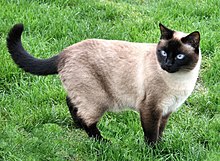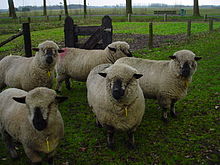Acromelanism

Acromelanism or point coloration is a genetically determined, temperature-dependent pigmentation pattern, with full expression only occurring on legs, ears, tail, face and scrotum (in males). It is most recognized as the coloration of Siamese[1] and related breeds of cat, but can be found in dogs, rabbits, rats, mice, sheep, guinea pigs, minks, and gerbils.[2]
Locus C in Mammals
[edit]The C Locus in mammals is most often associated with the TYR gene, which controls the production of the tyrosinase enzyme that produces melanin.[3]
In cats
[edit]
Point coloration in cats originated in the Siamese and closely related Asian breeds, and is found in many Western-developed modern breeds. It is a form of partial albinism resulting from a mutation that affects tyrosinase, an enzyme involved with melanin production. The mutated enzyme is thermolabile; it fails to work at normal body temperatures, but becomes active in cooler areas of the skin.[4] As a result, dark pigment is limited to the coldest areas of the body, that is, the extremities. Pointed kittens are born white, since the womb is uniformly warm. As the kitten ages, the cooler areas darken while warmer areas remain cream to white in color. Points are not limited to solid colors or dark colors. It is possible to have a red (orange color) or fawn (pale warm gray) point. It is also possible to have a tortoiseshell or tabby point. A cat (of any breed) with this coloration is often called a colorpoint cat to distinguish it from others.
As the expression of the gene responsible for the pointed pattern is regulated by temperature, pointed cats who live in cooler environments often show increased darkening of their fur relative to cats who live in warmer climates, sometimes even developing large dark areas along their sides.
Because of the pigment restriction caused by the temperature sensitive tyrosinase, pointed cats' eyes are always shades of blue because the blue layer in the eye common to all cats is not covered by another color. The back of the eye also lacks pigment, giving colorpoint cats' pupils an eerie red and silver reflection in the dark, unlike a normally pigmented cat's shining silver-green or -blue.
The point gene allele is at the C locus, where pure albinism is also carried, and is written as cs. Point is recessive, so two copies of cs, one from each parent, are needed for points to be expressed. Also carried on the C locus is the gene for the sepia pattern, which allele is represented by cb. This is the darkest of all of the pigment restricting patterns—pigment is only paled at the warmest point in the body: the abdomen. Sepia cats have amber-yellow to green eyes. When a cat carries the genes cs and cb, the intermediate mink pattern is formed, in which the pigment distribution is between sepia and point. The eye color of mink cats is on the blue-green spectrum (aquamarine).
- Comparison of different black (seal, sable) colourpoint cats
-
Black point Siamese
-
Black mink Tonkinese
-
Black sepia Burmese
-
Black tortoiseshell point cat
The lynx point pattern is formed by mating a colorpoint cat with a tabby cat (or breeding cats that already possess the lynx point pattern). It is characterized by a mixture of the darkening (reduced) of point coloration with distinct tabby striping on the head, tail, and legs, and an otherwise uniform and comparatively pale body. It is an accepted pattern in some cat registries, but not others, for particular breeds (mostly Siamese-related).
Point coloration is inherent to the Siamese breed and some other closely related breeds but with most other breeds the colorpoints (including lynx) were brought into some breed lines long after their establishment, but there are exceptions. For example, lynx point was a feature of some of the foundation stock of the Siberian, now called the Neva Masquerade.[5]
Cat breeds
[edit]In dogs
[edit]This section needs expansion. You can help by adding to it. (March 2021) |
Rarely, dogs may also have a point coloration similar to that of Siamese cats.[6]
In rabbits and rodents
[edit]
All pointed white rabbits of true breeding have red eyes.[7] The pointed white rabbit is created with the ch gene.[8] Its presentation is typified in the Himalayan rabbit breed (the first rabbit breed with a pointed white coat) and in the Californian breed.
Rabbit coat colors
[edit]Some rabbits that appear to be pointed white lack the red eyes, which indicates they are of different breeding. The following such coat colors are examples of those created, not with the ch gene, but with the cchl, cchd, or cchm gene in conjunction with the e gene:[citation needed]
- Blue point
- Chocolate point
- Lilac point
- Pearl
- Sable point
- Sallander
- Seal point
- Siamese
No pointed white rabbit can produce orange pigment; therefore, the points are always either black, blue, chocolate, or lilac.[citation needed] The resulting point coloration is sometimes in conjunction with a coat pattern, such as: white agouti, marten, broken, Vienna, or harlequin. (Such coats may not be recognized for showing.)
Rabbit breeds
[edit]Breeds of rabbit that include varieties with point coloration include:[9][10]
In fancy (domestic) rats
[edit]The C - Albino locus gene causes dilution of yellow and black coloration, causing Himalayan or Siamese markings depending on the allele is affected.
Point colors in rats include:
- Sepia
- Seal Point
- Blue Point[11]
In guinea pigs
[edit]There is only one type of guinea pig with a pointed coat. It is called the Himalayan, has either Black (a very dark brown) or Chocolate, tipped on the Ears, Nose, and Feet.
In sheep
[edit]
Some breeds of sheep exhibit point coloration.
Sheep breeds
[edit]References
[edit]- ^ Miller, W.H.; Griffin, C.E.; Campbell, K.L.; Muller, G.H. (2013). Muller and Kirk's Small Animal Dermatology7: Muller and Kirk's Small Animal Dermatology. Elsevier/Mosby. p. 620. ISBN 9781416000280. Retrieved 2015-05-17.
- ^ Petrij, F (2001). "A Second Acromelanistic Allelomorph at the Albino Locus of the Mongolian Gerbil (Meriones unguiculatus)". The Journal of Heredity. 1: 74-78. doi:http://dx.doi.org/10.1093/jhered/92.1.74.
{{cite journal}}:|access-date=requires|url=(help); Check|doi=value (help); External link in|doi= - ^ Kumar CM, Sathisha UV, Dharmesh S, Rao AG, Singh SA (Mar 2011). "Interaction of sesamol (3,4-methylenedioxyphenol) with tyrosinase and its effect on melanin synthesis". Biochimie. 93 (3): 562–9. doi:10.1016/j.biochi.2010.11.014. PMID 21144881.
- ^ D. L. Imes; et al. (April 2006). "Albinism in the domestic cat (Felis catus) is associated with a tyrosinase (TYR) mutation". Animal Genetics. 37 (2): 175–8. doi:10.1111/j.1365-2052.2005.01409.x. PMC 1464423. PMID 16573534.
- ^ TICA. "Siberian Introduction" (PDF).
- ^ Bychkova, Elina; Viktorovskaya, Olga; Filippova, Elizaveta; Eliseeva, Zhanna; Barabanova, Larisa; Sotskaya, Maria; Markov, Anton (2021). "Identification of a candidate genetic variant for the Himalayan color pattern in dogs". Gene. 769: 145212. doi:10.1016/j.gene.2020.145212. PMID 33039541. S2CID 222302410.
- ^ "Himalayan rabbit", Wikipedia, 2020-01-14, retrieved 2020-09-02
- ^ "Rabbit Color Genetics: Self Chinchilla Explained – Rabbit Smarties : Creative Resources for Rabbit Keepers". 19 July 2011. Retrieved 2020-09-02.
- ^ Standard of Perfection 2016-2020. American Rabbit Breeders Association. 2015. ASIN B018GVBJK4.
- ^ "Breed Standards 2016-2020" (PDF). British Rabbit Council. Archived from the original (PDF) on 21 January 2018. Retrieved 11 February 2018.
- ^ "AFRMA - Rat Genetics, part 1".





